By Ed Boitano, photographs by Deb Roskamp noted in the text.
After driving three hours into the burning desert of Egypt’s Sinai Peninsula, we arrived at our destination, Saint Catherine’s Monastery, officially the Sacred Autonomous Royal Monastery of Saint Catherine of the Holy and God-Trodden Mount Sinai.
As we stepped out of our van, the same team was with us as before: the well-versed driver; the official police officer; the two very nervous American tourist, who still continued to speak ceaselessly of the nearby war; and our highly educated guide, Salaam, who thought it best to simply smile when the two very nervous American tourists would rant.
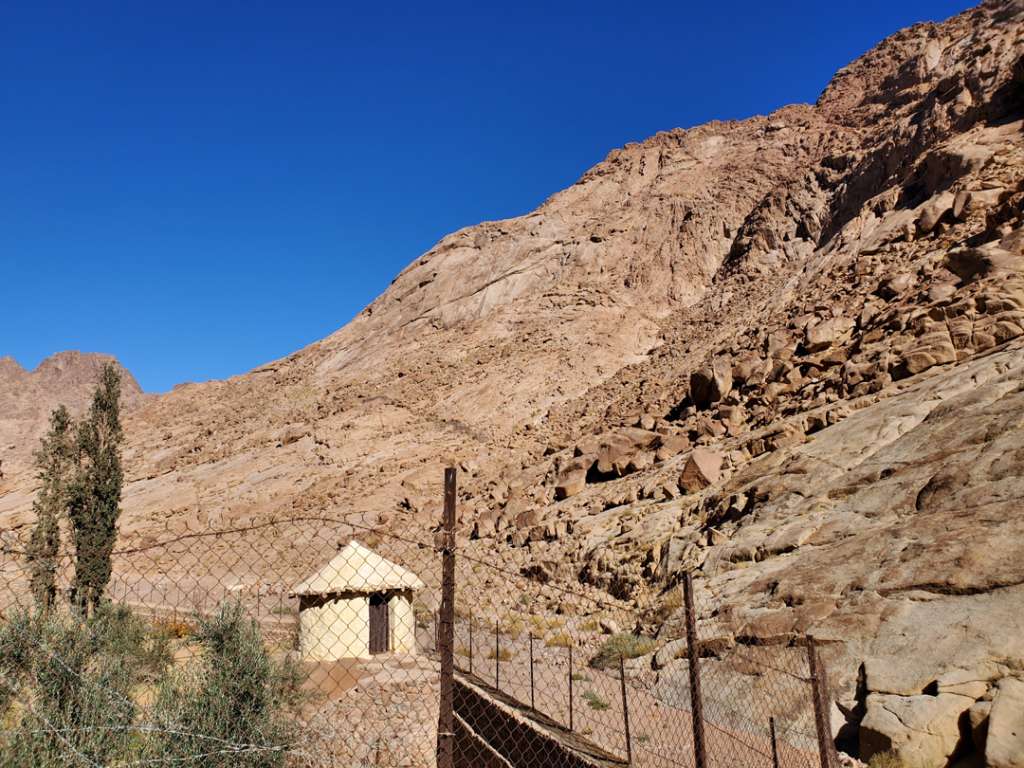
Saint Catherine’s Monastery was sanctioned by the orders of the Byzantine emperor Justinian I, between 565-548 B.C.E. But, in the year 330 A.C.E., the Empress Helena, the mother of Roman Emperor Constantine the Great, built a church with massive granite blocks, believed to be on the site where God spoke to Moses through the burning bush.
We had to advance deep into the valley for there are many hermit cells and a shrine at the site of the Bush. The Bush is verdant to this day. This is the Bush of which I have spoken earlier, the one from which God in a flame of fire spoke to Moses. – Author unknown.
The first Byzantine Orthodox monks arrived approximately around year 330 A.C.E., and still live according to the traditions of the early Christian monastic order, based on the spirituality of the desert – Because life in the desert is cruel and harsh, but it is here where one may find God.
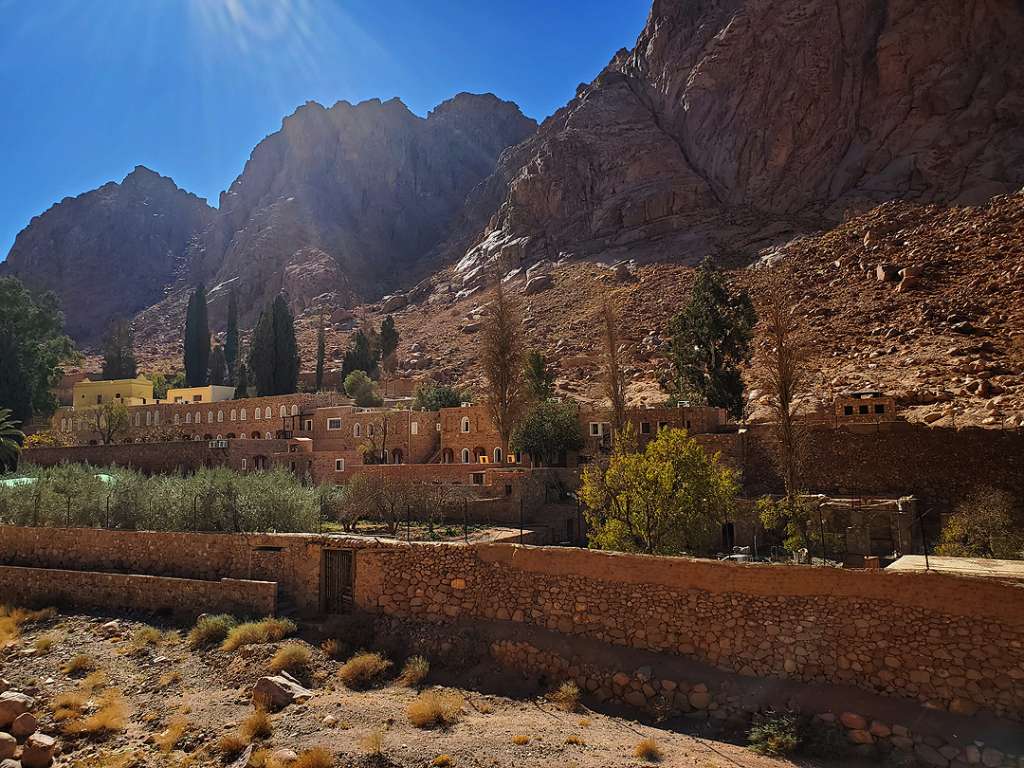
The monastery was eventually renamed after Saint Catherine of Alexandria, a saint in Europe’s Catholic Christology, during the Middle Ages, who was sentenced to death in her defense of other Christians. Her body was placed on a spiked breaking-wheel, but, at her touch, the wheel shattered to pieces. It was then ordered that she be beheaded. Centuries later her body was said to be found in a cave close to Mt. Sinai, and was taken to the monastery. The relics of Saint Catherine, which are kept inside the monastery today, continue to inspire pilgrimages from people throughout the world.
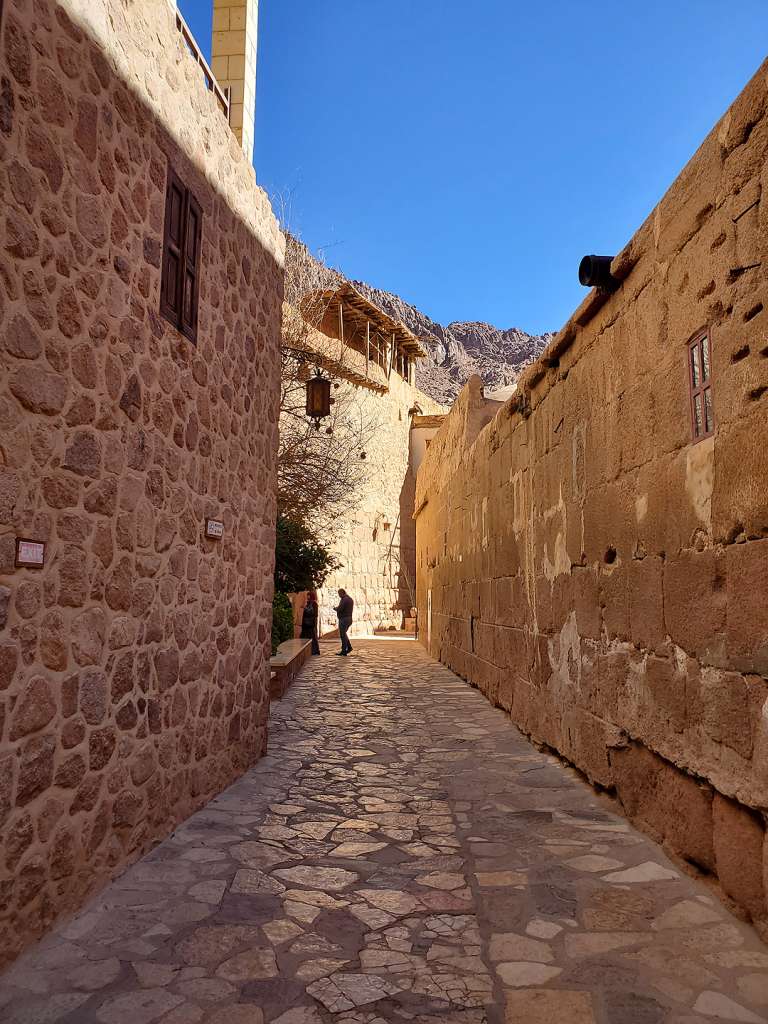
Controlled by the autonomous Church of Sinai, which is part of the wider Greek Orthodox Church, Saint Catherine’s Monastery became a UNESCO World Heritage Site in 2002 for its unique importance in the traditions of Christianity, Islam and Judaism. The site holds the world’s oldest continually operating library, along with rare works, such as the Codex Sinaiticus and the Syriac Sinaiticus, and, but still debated, the largest collection of early Christian icons. Also inside is the earliest known depiction of Jesus as Christ Pantocrator, which represents the dual nature of Christ, illustrating traits of both God and humankind.
Saint Catherine’s Monastery and the area consumed by Mount Sinai also remains sacred to the monotheistic religions, Judaism, Christianity and Islam.

The climate was cool when our group stepped into the rooms of Saint Catherine’s Monastery, taking refuge from the staggering desert heat outside. The monastery was compact, almost like an ancient city with chambers, pathways and gardens, captured between four granite walls.
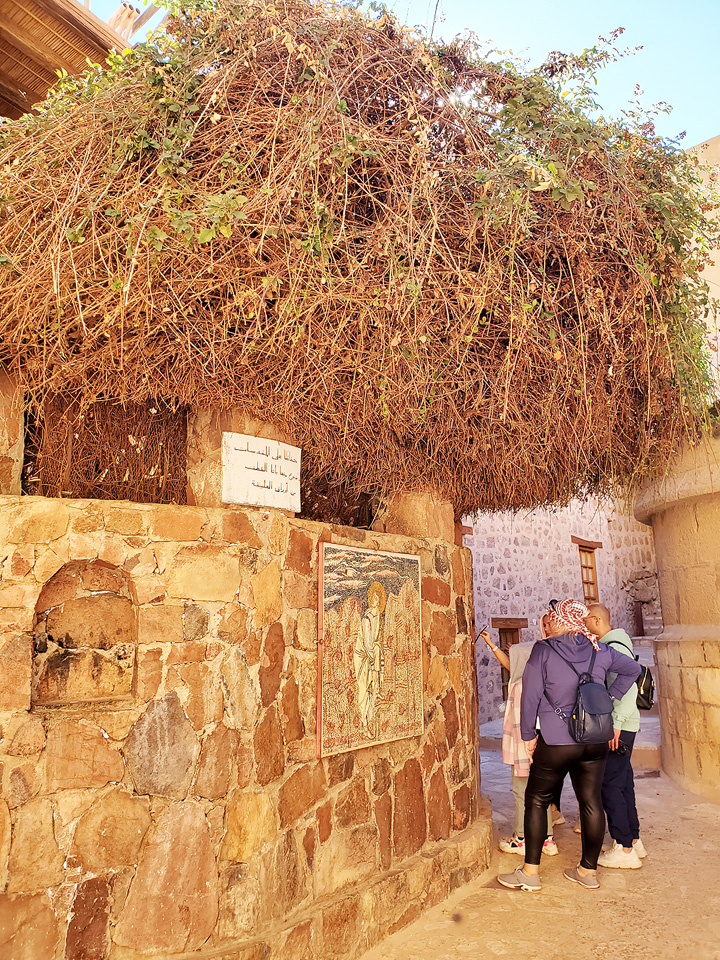
It was easy to find the purported Burning Bush, or the Bush which no longer burns, as we assume it is a remnant where most had disappeared into ashes long ago.
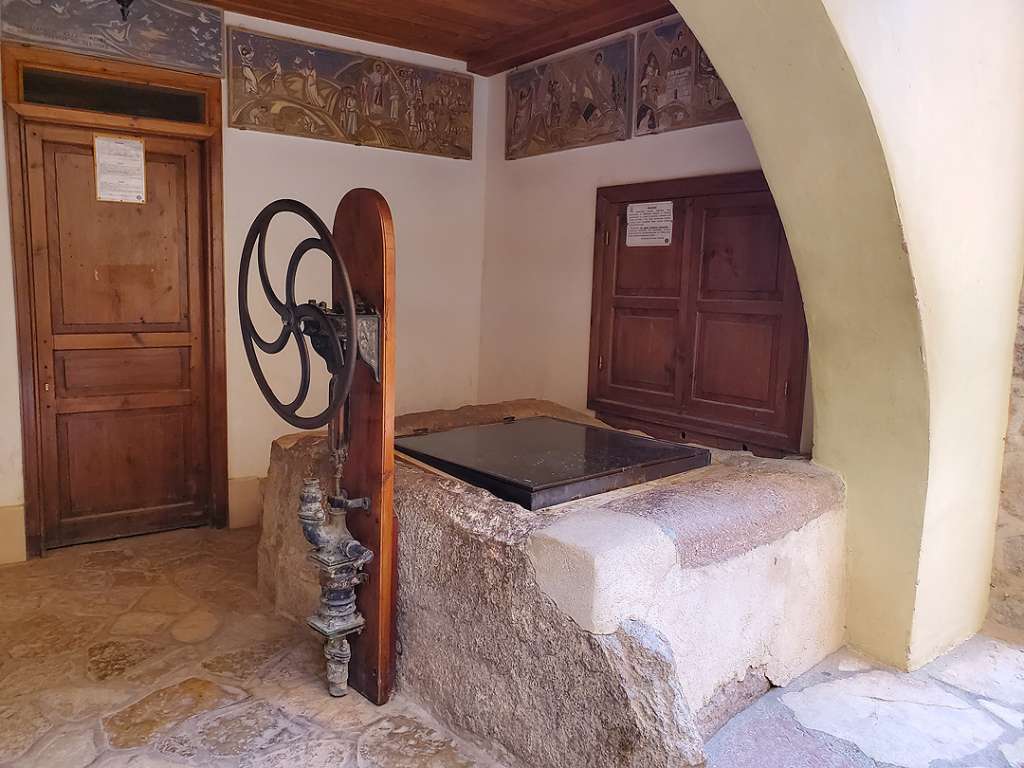
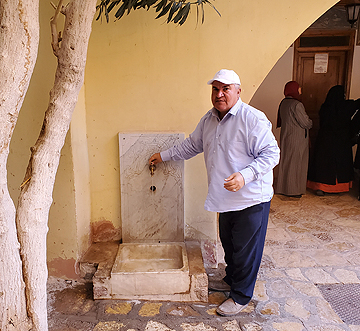
Soon, we spotted the Well of Moses, where Moses apparently met his future wife, Zipporah. The Well remains today as one of the monastery’s main sources of water. As I took a sip of water from its drinking fountain, I wanted to to believe it was all true.
We quietly walked into the main chapel with a strong sense of reverence, and were surprised by the small size of the worship room, which was clearly overburdened with many icons and relics. We noticed on the other side of a short, waist high, dividing wall that an elderly monk was deep in prayer, and wondered what he was praying for. The dividing wall made it clear that it served as a threshold that should never be crossed. And we also assumed that after the monk had finished his prayer, not a single word should ever be crossed. But the moment he saw us, he walked over to greet us and gave us a warm hello. He asked where we had traveled from, and we told him that we had traveled a long way from the United States, which he nodded was truly a long way. And then replied with a grin, You know, I have a cousin in the United States… who owns a restaurant in Philadelphia.
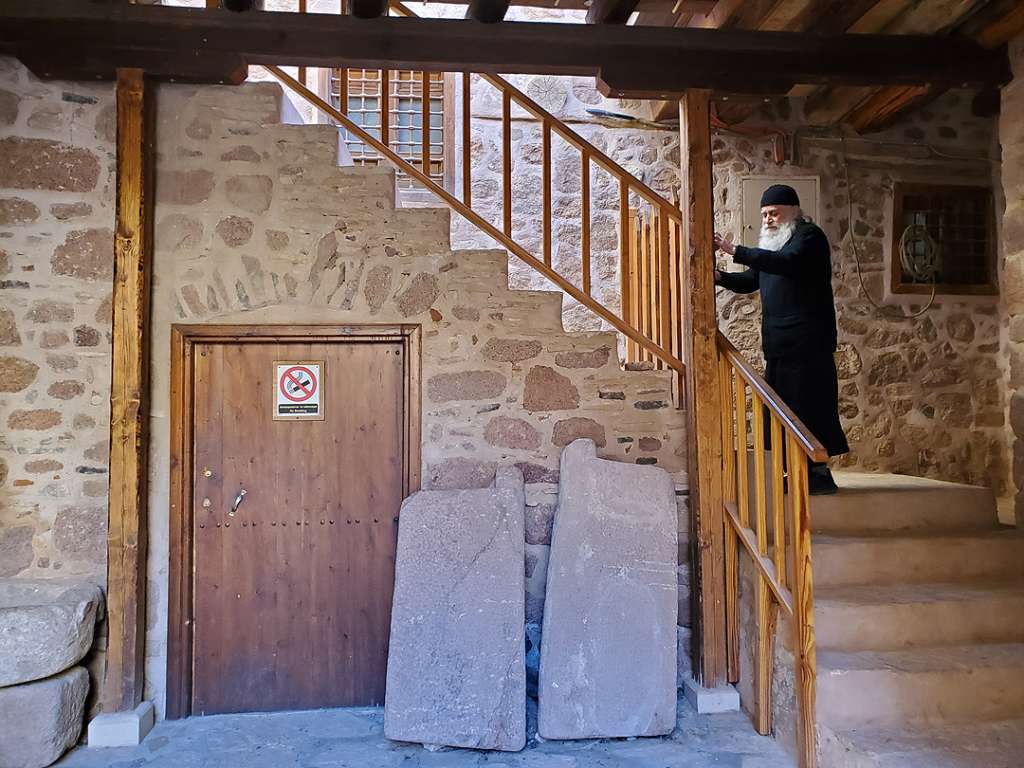
As we bid farewell, we promised that if we ever did return to Philadelphia, we would look his cousin up. But decided not to mention that the City of Brotherly Love, the birthplace of our republic, is often referred to as the City of Brotherly Shove.
The time was too brief for our tour, as the doors at Saint Catherine’s Monastery would soon be closed for tourists, but it was important for our group to realize the ritualized monastic life. Priests meet in the morning at 4:00 a.m. and pray in their cells until eight a.m., followed by a one-hour period of rest. And then, each monk begins their assigned task; working in the library, the garden, cleaning icons, etc.
The first meal is lunch at 1:00 p.m., where all monks eat in silence while a novice reads religious texts. From 1:30 to 5:00 p.m., there is another resting period, after which vesper service is held until 7:00 p.m., and the monks return to their cubicle. At 10 p.m. the lights are extinguished, but the monks are allowed to read in their monastery cells by candlelight.
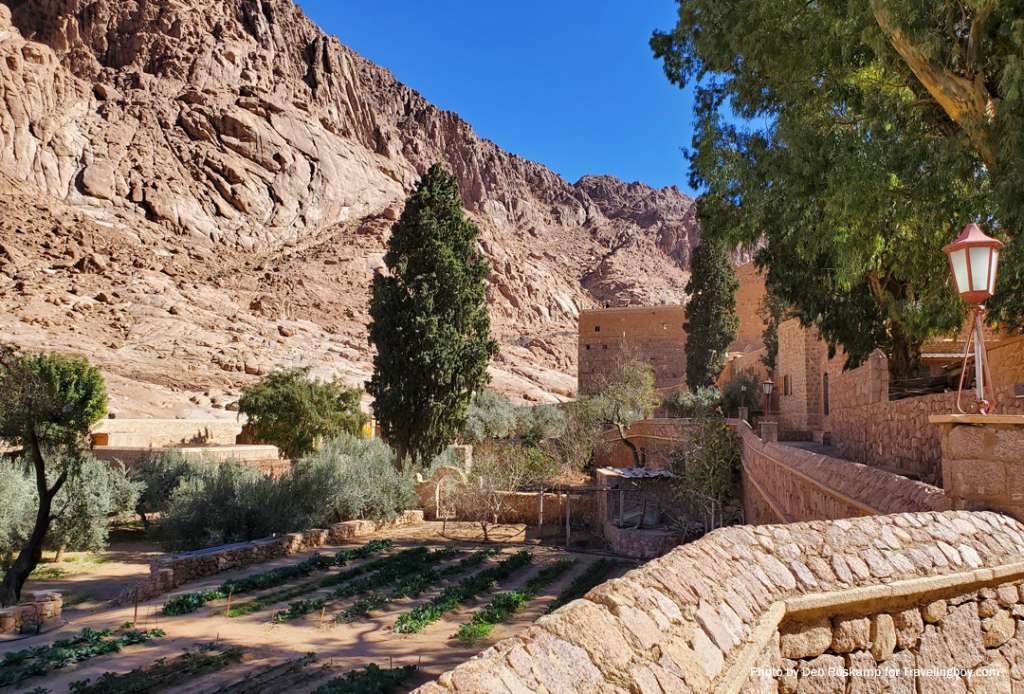
The monks fast three days a week, followed by eating simple vegetables, all grown from well-maintained gardens. It was a stroke of genius or part of God’s Holy plan, that the monks had managed to create one in the rough landscape of unbearable heat and endless desert sand. There were also many citrus and olive trees, where the olive itself is often a symbol which defines Greek and Mediterranean life the best.
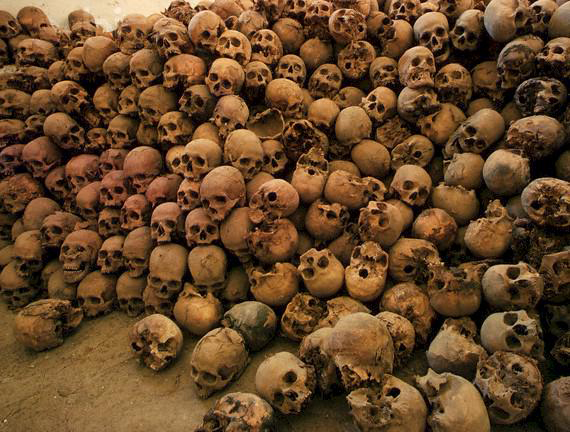
In the garden rests a small cemetery within the Chapel of St. Tryphon and the Charnel House. The sparsity of earth does not permit permanent graves, so the monks buried in the cemetery are later exhumed and their bones placed in the ossuary. One of the oldest remains is of the hermit, Stephanos, a 6th century monk, who is believed to have lived on Mount Sinai in a small dwelling, where he solemnly struggled on behalf of his own monasticism.
As the monastery’s clock ticked down to 1 p.m., we took a mad cap dash to the small gift store for postcards, gifts and souvenirs. To our surprise, the monk behind the counter turned out to be the one with a cousin in Philadelphia, with whom we had met earlier before. As we hurriedly piled our growing load of treasures onto the counter, I wondered if I should suggest that perhaps there should be a slight discount. But I assumed what the kind monk would smile and say, All profits go to God, who looks down upon us now. Back home, I wondered where the profits of a bible marketed by a former U.S. president would really go; for he too looks down upon us, but in a very despicable way.
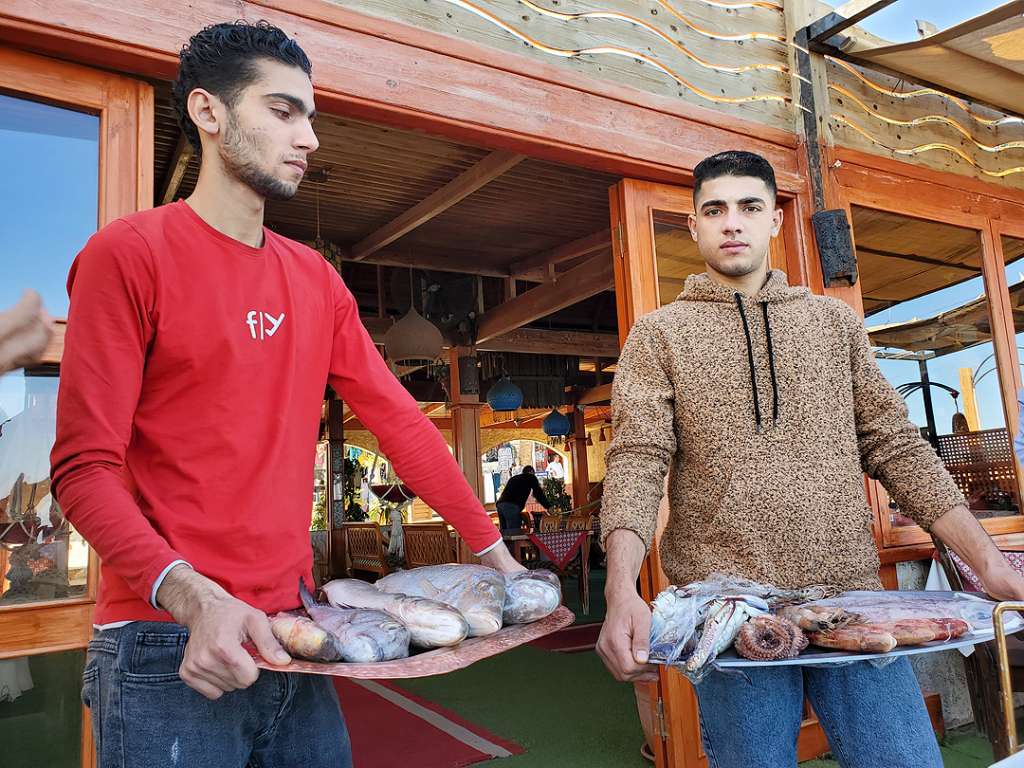
When we left Saint Catherine’s Monastery, we hopped back into the van for the long ride back to Sharm El Sheikh. Thinking of the monk’s cousin, food was soon on our mind. So, halfway through our trek, Salaam suggested we should make a hard right turn to a local seafood restaurant on the Red Sea, where the very polite staff of Egyptian waiters presented a large platter of seafood, caught that very day. We were curious, and not sure why; Salaam, our driver and policeman chose to sit inside. Perhaps they needed a break, before realizing they probably needed a break from me.
After we made our selections, we realized the authenticity of a real seafood restaurant, unlike the rather faux ones at Sharm El Sheikh’s Four Season’s restaurants. Our meals had been enjoyable at Sharm El Sheikh, but this late lunch easily tipped the scales, serving the best meal during our entire three-weeks in Egypt.
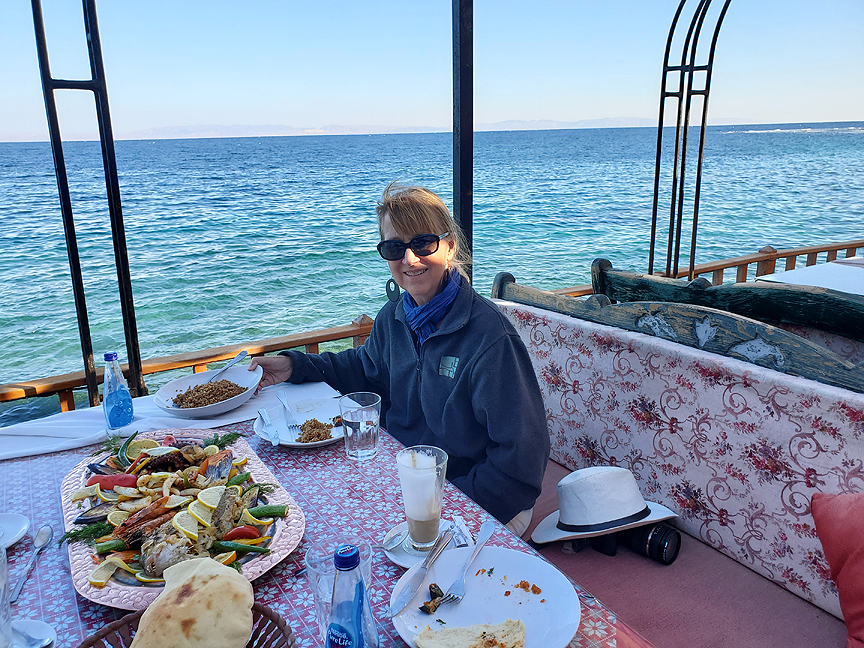
Our balcony table was set just above the shore’s waters. It occurred to me that this was as close as we had ever been to the historical and biblical waters of the Red Sea, the waters which I had imagined I would dive into the moment after our immediate arrival to Sharm El Sheikh. But then I remembered that tomorrow would be a very different kind of day.
Red Sea Underwater Adventure
The following day after we left our resort property at Sharm El Sheikh, we really did tip our feet into the Red Sea. The holy act was the first act for a planned underwater adventure, which I refer to as a hybrid tourist vessel, where the lower body of the ship drops down below the water’s surface, while the top remains above.
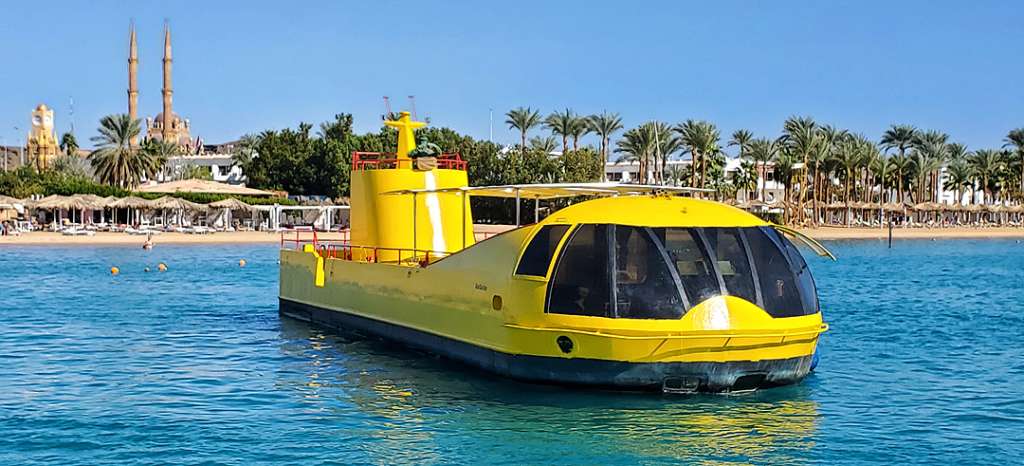
After cruising out of the congested mooring, we shuffled down a flight of stairs to witness the Red Sea’s underwater eco-system, home to over 300 species of coral and 2,100 species of fish from the vantage point of two long observation windows. What I found more interesting was another kind of hybrid on the boat: Russian, Egyptian and North American tourists.
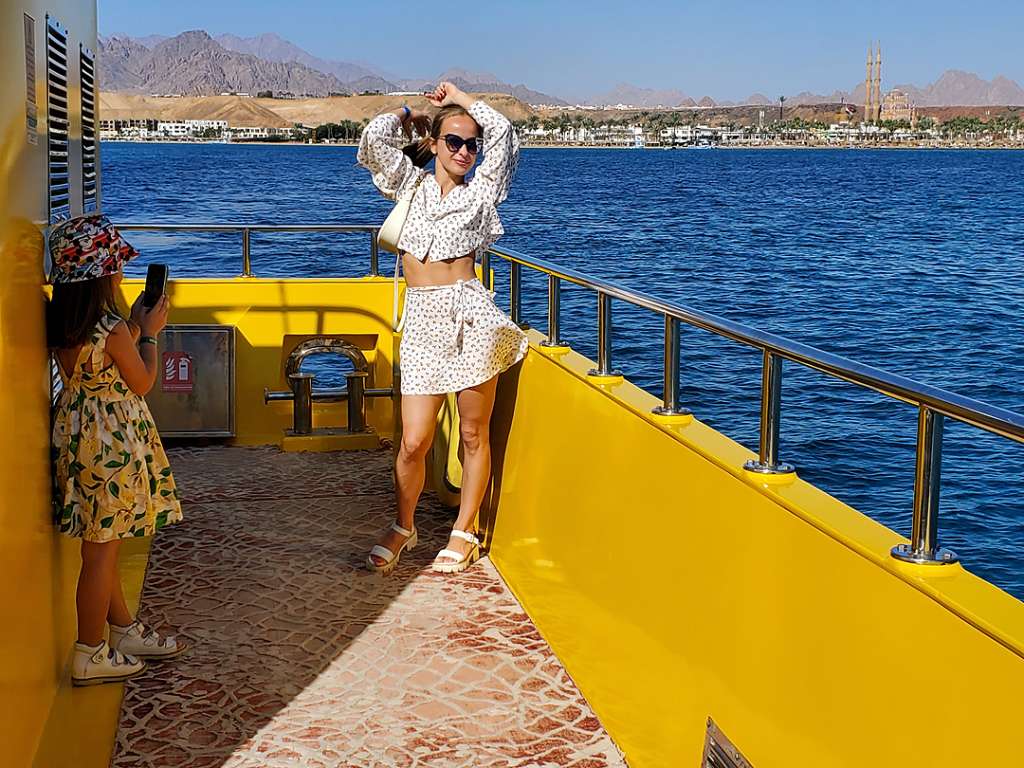
The Russian passengers were polite, and basically kept to themselves, but were enthusiastic and appreciated the underwater wonders on the other side of the hybrid boat’s windows. The women seemed fashion conscious, were well dressed in vibrant colors, many with trendy sun glasses. They paid great attention to their mobile phones, and were generally part of large groups or families. It was easy to see they were from landlocked areas in Russia, and this was a vacation of a lifetime.
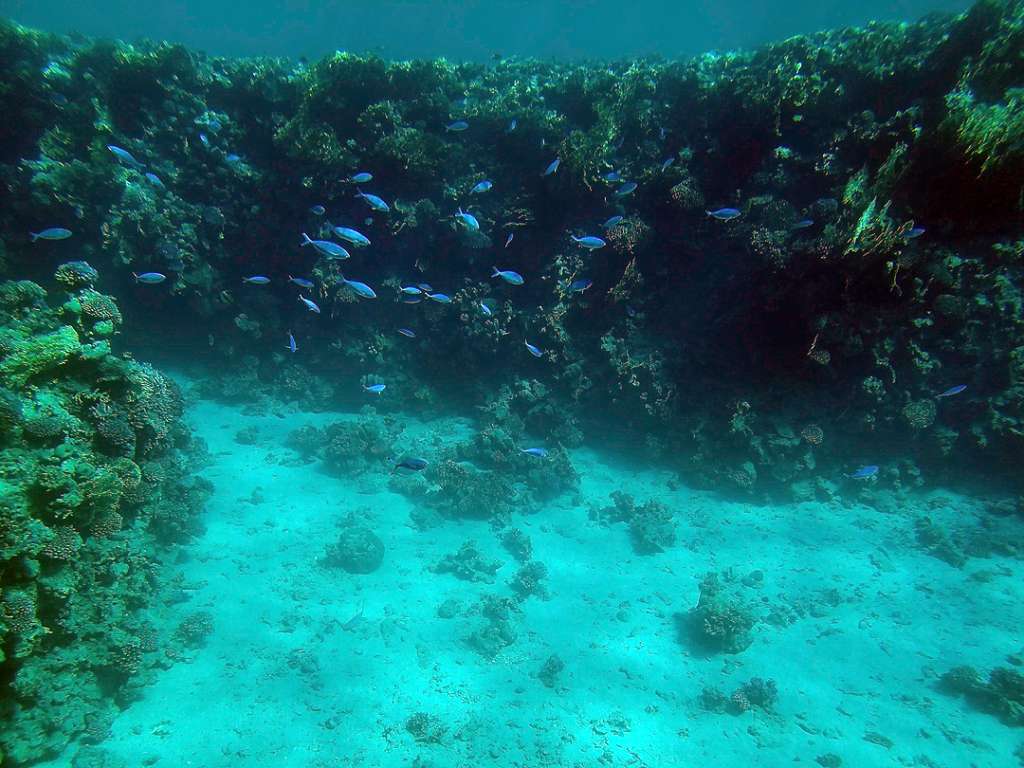
Many of the Egyptian passengers were busy as workers on the vessel, but the others seemed open, and easy to please, and simply happy to be there.
As for the North Americans… well, we were North Americans, but also seemed pleased to be part of this fascinating hybrid experience.
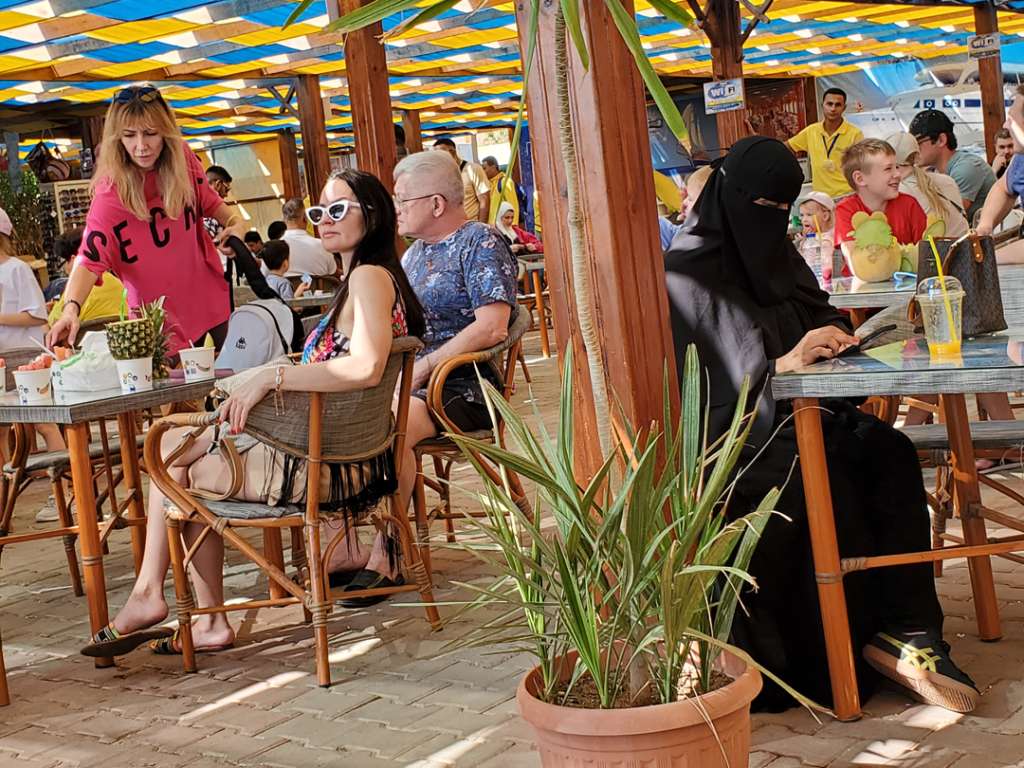
One of the most colorful moments was a post-cruise lunch, where we saw an attractive-looking Russian woman, dressed in typical beach clothes and sandals, after speaking on her mobile phone. Seated at the next table, was an attractive Egyptian woman, dressed in a black burka and tennis shoes, after speaking on her mobile phone. Two divergent worlds, unbeknownst to each other, were sitting back-to-back at their tables. Did someone really say, Truth is stranger than fiction?
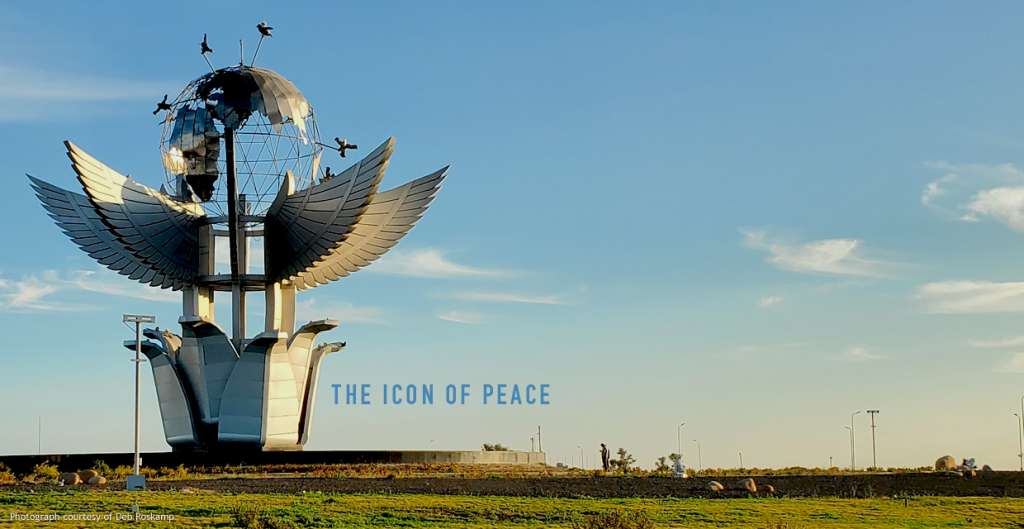
The next day we departed from the Sharm El Sheikh Four Seasons Resort. As we passed its gates, the Icon of Peace was standing as it was before. The above image was used in an earlier installment, but it never can be seen too often as the world struggles to seek international peace.
A few hours later we were on a plane and gone.
Related Articles:























Katlyn
May 20, 2024 at 1:18 pm
Interesting article. I didn’t know there was a Christian church in Egypt.
Burt
May 20, 2024 at 1:22 pm
I kept on looking at the Icon of Peace wondering what was wrong. I think it’s the globe … or at least what I think is the globe.
It’s incomplete. I don’t think North and South America are represented. Neither is Asia. If I’m guessing right, it’s just the Middle East and Europe.
If so, how can this represent peace on earth?